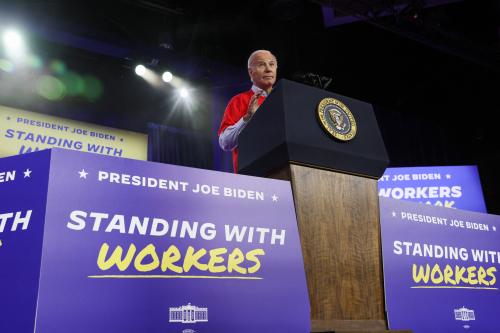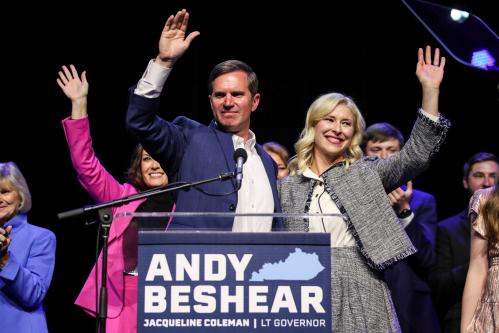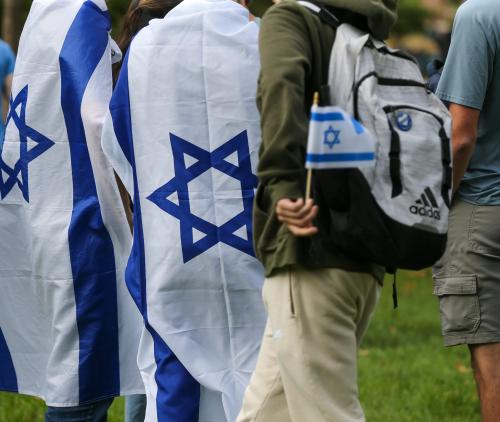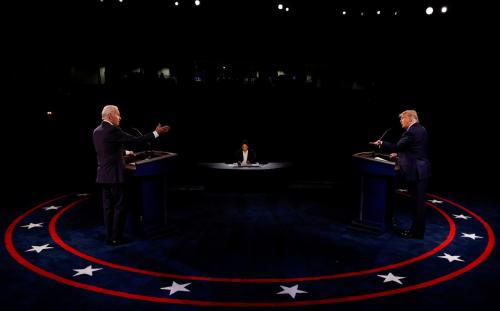In this series, we track key election metrics for presidential candidates throughout the campaign period known as the “invisible primary.”
The list of presidential candidates included is based on the candidates listed in AP News, The Washington Post, The New York Times, and Politico’s descriptions of the 2024 field.
We are now about eight weeks away from the end of the invisible primary. On January 15, 2024, voters will vote in the Iowa caucuses followed days later by voters in the New Hampshire primary on January 23. For months now, ever since we began tracking the progress of the candidates in the invisible primary, the race to the nomination has been pretty stagnant. Former President Donald Trump has maintained large leads over all his competitors in the metrics we can track: polls, amount of money raised, attention from the media, and number of followers on social media. To the dismay of many Americans, conventional wisdom has remained unchanged; The 2024 presidential election will be a rematch of the 2020 election — Trump versus Biden.
But wait. Presidential nomination races differ from all other elections in America for one simple reason: They occur over a period of six months in a sequence where winning in one race can yield a political commodity even more precious than money — momentum. Momentum can have dramatic and unexpected impacts on subsequent races. Thus, between January and June of next year, the conventional wisdom could unravel. It has happened to front-runners before, and it could happen again. So how likely is an upset?
Don’t expect an upset in the Democratic primaries. President Biden faces opposition from only three candidates, spiritualist and author Marianne Williamson, who ran last time and didn’t get anywhere, left-wing activist Cenk Uygur, who was not born in the United States and thus can’t become president even if, by some miracle, he catches on, and two-term Minnesota Rep. Dean Phillips who agrees with Biden on most things but just thinks he’s too old. (Biden has to worry about third-party candidates like Robert F. Kennedy Jr. who has shown some movement in the past few months, but that’s a topic for another day.)
On the Republican side, the question is the same now as it has been for months: Can anyone emerge to become the Trump alternative? Slowly but surely, we may have an answer — former South Carolina Governor Nikki Haley.
Here’s what we are seeing.
In national polls, Trump retains a solid lead. In fact, as has been often noted, his standing seems to have improved with his indictments, and from April to mid-November 2023 he has remained solidly above 50% in national polls according to FiveThirtyEight’s average of polls.
Florida Governor Ron DeSantis, who began the year as the likely opponent to Trump, has seen a steady decline in his poll numbers from the mid-30s in January to the mid-teens in November. Former Governor Nikki Haley began rising in July and is now third in the average of national polls. All other candidates stuck at the bottom have shown no appreciable movement.
Remember, however, that national polls in primaries are limited in their predictive value. What really matters are polls in the early states. These four states — Iowa, which will hold its Republican caucuses on January 15; New Hampshire, which will hold its Republican primary eight days later on January 23; Nevada, which will hold its Republican caucuses on February 8; and South Carolina, which will hold its Republican primary on February 24 — have the potential to dramatically reshape the race for the Republican nomination.
Typically, poor showings in these early states cause many of the poorly performing candidates to drop out. This will be extremely important this time around because, given the loyalty of the Trump base, the only chance someone has to beat Trump would be to engage him in a one-on-one race. In the early states, the polling trajectory is similar to the national picture in that Trump has maintained a steady lead. However, his lead in Iowa, New Hampshire, and South Carolina has remained in the 40s, not the 50s, throughout this year — he is 10 points weaker in those states than his national numbers would suggest. As for the other candidates, Florida Governor Ron DeSantis has steadily lost altitude since the beginning of the year, and all the others have been stuck in the under-10 percent range with the sole exception of former South Carolina Governor Nikki Haley.
Consequently, Haley now looks like the most likely Republican to catch the “big Mo” and turn the race into a one-on-one race against Trump. In the average of Iowa polls, she is a close number three to DeSantis with a trajectory that is clearly good.
The esteemed Des Moines Register poll has her tied with DeSantis in Iowa.
It looks like she is going to get one of the three famous “tickets” out of Iowa, and while second is better than third, if they are close, it will still help. DeSantis has doubled down on Iowa and a third-place finish there could end his hopes.
In New Hampshire, Haley surpassed DeSantis last month and has held on to the number two slot while DeSantis and Chris Christie are in close contact for the third spot.
And in her home state of South Carolina Haley has been holding a lead over DeSantis for the number two slot since September.1
Haley’s fortunes have been going in the right direction in some other areas as well. Our primary tracker tracks media mentions, and there Haley has increased her attention from the media, placing third among Republicans behind Ron DeSantis and Donald Trump. She finished last quarter’s fundraising with as much cash on hand as DeSantis, and while actual fundraising numbers will not be available until the end of December, anecdotal evidence suggests her fundraising is on an upswing. And she has increased her following on X (Twitter), Facebook, and Instagram.
If Haley’s invisible primary momentum increases in the next eight weeks and she has an unexpectedly strong showing in Iowa, it could propel her into a close second with Trump in New Hampshire. If she gets the endorsement of Republican Governor John Sununu in the New Hampshire primary, it might help turnout among non-Trump Republicans and Republican leaning independents. (Independents can vote in the New Hampshire primary.) If some other candidates drop out and endorse her, it could help her win her home state of South Carolina or at least come close to Trump. And if her momentum turns into cold, hard cash (as it almost always does), she might be able to go one-on-one with Trump when the real race begins on Super Tuesday.
Of course, there are a lot of ways Haley could turn into simply the flavor of the month. Her strength has come from her debate performances, and she has two more in front of her before the voting begins. A bad debate performance could end her run. If DeSantis or Ramaswamy withdraws or is badly beaten, their voters are more likely to go to Trump than to Haley. (But if Chris Christie decides to get out of the race, his voters will most probably go to Haley.) And finally, momentum from the early wins may not be enough to propel Haley over Trump in the big states that follow, given the intense loyalty he controls in the Republican base.
Nonetheless — the invisible primary seems to have replaced DeSantis with Haley as the most likely candidate to take on Trump. The real show is just weeks away.
-
Acknowledgements and disclosures
Thanks to Cambron Wade, Anna Heetderks, Jordan Muchnick, Owen Averill, Annabel Hazrati and Adelle Patten for their work on data collection and data visualization.
Google and Meta are general, unrestricted donors to the Brookings Institution. The findings, interpretations, and conclusions posted in this piece are solely those of the author and are not influenced by any donation.
-
Footnotes
- The fourth early state, Nevada, is unlikely to contribute much to the momentum of the Republican race. They will hold caucuses on February 8, and only some candidates — not including Trump — will be on the primary ballot on February 6. Thus, if Haley emerges as the “hot” candidate, there will be no contest in Nevada where she can go head-to-head with Trump.






Commentary
Tracking the invisible primary: Will Nikki Haley be the surprise?
November 20, 2023